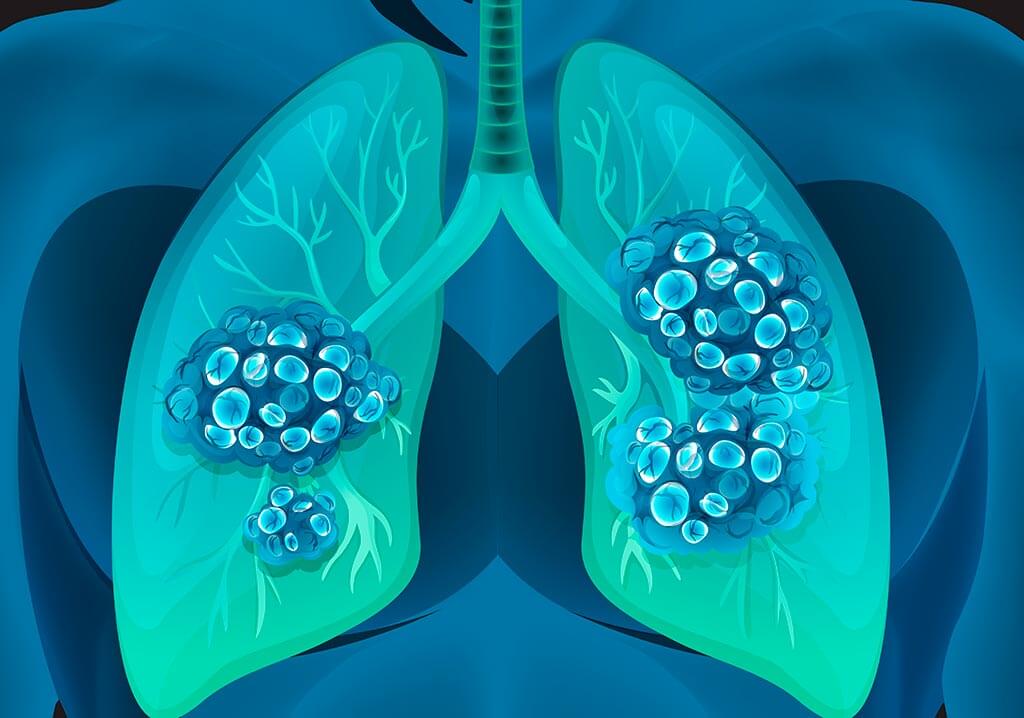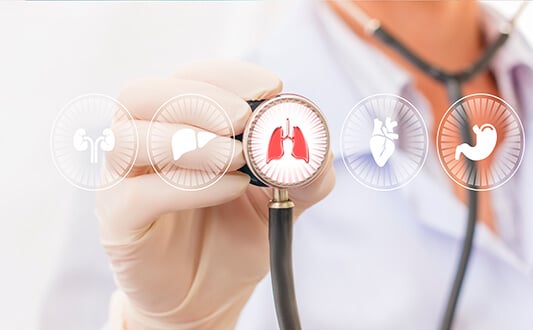Lung cancer is the most common oncological cause of death in men. This type of cancer is difficult to treat and in most cases it is diagnosed at an advanced stage. Lung cancer is 5-7 times more common in men. However, in recent years, there has been a trend towards a gradual decrease in this ratio. The disease is increasingly diagnosed in women as well.
Content
- What is lung cancer?
- Metastases in lung cancer
- Symptoms of metastatic lung cancer
- The principles of lung cancer staging
- Initial stages of lung cancer
- Lung cancer of the 2nd stage
- Lung cancer of the 3rd stage
- Lung cancer of the 4rd stage
- Modern stage 4 lung cancer treatment options
- Specialized hospitals and cost of lung cancer treatment
- Services of Booking Health for lung cancer patients
- Cost of the surgical lung cancer treatment in different countries
What is lung cancer?
One of the most life threatening oncological diseases is lung cancer. Why is this so? It is a malignant tumor that rapidly increases in size and causes metastases. Most people know that smoking causes lung cancer, thanks to the health warning advertised on the pack of cigarettes. Nevertheless, people continue to smoke and die from this malignant neoplasm.
Few people know what lung cancer actually is. Most people think that the tumor develops from the lung tissue. In fact, what is called lung cancer is essentially a malignant neoplasm of the bronchi. It develops from the epithelium of the bronchial mucous membrane. According to histological structure, small cell and non-small cell lung cancers (including squamous cell lung cancer) are distinguished.
Here are the main features of the disease:
- Adverse prognosis. About 50% of patients will not survive even 1 year after receiving the diagnosis.
- Late detectability. Especially in case of peripheral lung cancer, when it develops from the small bronchi. Symptoms are practically nonexistent, or they are very mild. There can be cough, but the patient perceives it as chronic bronchitis and does not pay much attention. Lung cancer is not accompanied by pain, which also causes late detection of the disease. There are no sensitive nerve endings in the lung tissue. Therefore, pain appears only after the tumor has spread to the pleura.
- Rapid metastasis. Lungs are responsible for saturating the blood with oxygen. Therefore, it has a very good blood supply. The abundance of lymphatic and blood vessels leads to lung cancer metastasizing very quickly.
Metastases in lung cancer
This type of cancer metastasizes rather rapidly. People often wonder at what stage of lung cancer do metastases develop. They form in the 2nd stage in the nearest lymph nodes. Lung cancer metastases to distant organs and tissues already by the 4th stage of lung cancer.
There are three ways how tumor can metastasize:
- Hematogenouc
- Lymphogenic
- Implantation
The lymphogenic way is the first one to develop. Pulmonary lymph nodes are located in the lung tissue, at the points of division of segmental bronchi. Bronchopulmonary lymph nodes are located at the entrance of lungs. Another group, where lung cancer can metastasize, is tracheobronchial and bifurcation lymph nodes. They are located where the trachea is divided into two main bronchi: the right and the left one. Paratracheal lymph nodes are also located near trachea. Later, lung cancer metastasizes to the near-esophageal lymph nodes, causing symptoms of an esophagus cancer. Dysphagia occurs- there is difficulty swallowing and food does not easily pass through the esophagus.
Metastases can also spread by the hematogenous way - through the blood. They are most likely to appear in the liver, where lung cancer metastasizes in 42% of patients (data obtained from autopsy results). Metastases are found in the kidney in 16% of people who died as a result of lung cancer. In 15% of patients metastases are detected in bones and adrenal glands. The separate article is devoted to methods of bone metastases treatment. Metastases which spread to the brain are also often diagnosed. Secondary tumors can also be found in the bone marrow.
However strange it may sound, lung cancer also gives metastasis to the lungs. They are found in 24% of patients according to autopsy data. As already mentioned, the disease, despite its name, primarily develops from the bronchial mucosa. However, later on metastases can spread to the lung tissue through blood vessels. Multiple carcinomatosis can also appear.
Finally, we need to determine how lung cancer metastasizes by implantation. The tumor gradually increases in size and spreads to the pleura. This is the shell that surrounds the lungs from the outside. As a result of metastases in the pleura, pleural carcinomatosis and cancerous pleurisy develop.
Symptoms of Metastatic Lung Cancer
Often, the first symptoms of lung cancer depend on the location where lung cancer gives metastases. The symptoms of lung cancer are most often manifested by the onset of metastatic foci in the mediastinum. The tumor spreads to the lymph nodes, which rapidly increase in size and squeeze the surrounding organs and tissues. This form of lung cancer is called mediastinal. Sometimes metastases affects the lymph nodes around the superior vena cava. This can cause facial swelling, dyspnea, cyanosis (blue color) of the skin and appearance of the venous network on the chest wall.
If lung cancer metastasized to the central nervous system, it is manifested by focal symptoms. There may be paresis, paralysis, problems with speech, vision and other functions, depending on the location of the secondary tumors. All patients who were detected with tumor in the lungs undergo brain examination for the purpose of detecting metastases. Most people suffer from symptoms associated with brain damage, but in 10% of cases metastases in the central nervous system are not manifested by any symptoms. This is due to its location in the "silent" areas of the brain.
The most frequent organ where lung cancer metastasizes is the liver. With it had been affected by lung cancer, patients complain of pain in the right upper quadrant. They may develop jaundice, ascites (accumulation of fluid in the abdominal cavity) and a venous network on the abdomen. Symptoms depend on the localization of metastases and their size. Over time, they can lead to liver failure. Bleeding from the blood vessels of the liver often becomes the direct cause of death in patients with lung cancer. Such an outcome is more likely if the primary tumor has a relatively small size.
The principles of determining the stage of lung cancer
The stages of lung cancer are established on the basis of three parameters:
- Main tumor
- Near metastases
- Distant metastases
They are denoted by letters T, N and M, respectively. Below are the basic signs used in the diagnosis and determination of the lung cancer stage.
Primary tumor
- Tx - tumor cells are found, but the tumor itself can not be determined, or its evaluation is impossible.
- T0 - primary tumor is absent (cancer may manifest itself by metastatic tumors, while the primary neoplasm remains very small and invisible).
- Tis - cancer is localized (it does not go beyond the bronchus).
- T1 - tumor in the lungs is no more than 3 cm, does not extend beyond the pulmonary parenchyma and does not germinate the pleura. According to bronchoscopy it does not extend beyond the lobar bronchus.
- T2 - the tumor is larger than 3 cm, the main bronchus is affected, the tumor spreads to the visceral pleura. There may be atelectasis - a decline in the proportion of the lung, when the alveoli do not fill with air and do not straighten.
- T3 - a tumor of any size spreads to the thorax, diaphragm, mediastinum, pleura or heart sac. T3 can also be determined if there is atelectasis of the entire lung or if the main bronchus is damaged when the tumor is less than 2 centimeters from the keel of the trachea (the site of its separation).
- T4 - is diagnosed when the tumor spreads into the esophagus, heart, blood vessels, trachea, spine, distant lung lobes, or if metastatic pleurisy develops.
Regional metastases
- Nx - it is not known if there are any near metastases
- N0 - the patient was examined and there are no metastases
- N1 - there is metastatic damage to the basal or intrapulmonary lymph nodes
- N2 - the lower tracheo-bronchial lymph nodes or nodes of the mediastinum are damaged, but only on the side of primary tumor localization
- N3 - there are metastases in the prelestinal, supraclavicular or basal lymph nodes on either side of the main tumor
Remote metastases
- Mx - it is not known whether there are metastases in distant organs and tissues
- M0 - no metastases
- M1 - distant metastases were detected
Initial stages of lung cancer
As it is known, there are four stages in lung cancer. However, there are actually six of them, because there are three, not one, initial stages of lung cancer:
Latent cancer. Denoted as TxN0M0. This means that the primary tumor was not detected. However, the biopsy of the bronchi and cytological analysis showed the presence of atypical cells in the material.
Stage 0. Denoted as TisN0M0. Cancer is detected, but the primary tumor is concentrated in the bronchial mucosa and does not extend to the lung parenchyma. This is a favorable form of the disease. Another name of this cancer stage is compensated cancer. This means that the tumor can not grow, because the body restrains its increase in size. The tumor can stay at this stage 5-10 years and more. This stage of lung cancer is rarely diagnosed. There are no symptoms. Accordingly, there is no reason for a person to be examined.
The 1st stage. Lung cancer of the first stage is characterized by the absence of any metastases: both near and distant. There are 2 substages: A and B. The difference is that substage A is characterized by the primary tumor T1, whereas sub-stage B is characterized by the presence of T2 tumor.
Lung cancer of the 2nd stage
Stage 2 of lung cancer is characterized by the appearance of metastases in the nearby lymph nodes. However, there are no distant metastases yet.
According to the international classification, lung cancer of the 2nd stage is divided into two sub-stages: A and B. They differ only in the characteristics of the primary tumor. In substage A, the tumor corresponds to T1. In substage B, the primary tumor tissue corresponds to T2 or T3. At the 2nd stage cancer can be quite severe, which presents an unfavorable prognosis for the patient's life. However, if the primary tumor meets the T3 criteria, then the 2nd stage is diagnosed only if there are no near metastases. If they appear, it is already considered lung cancer of the third degree.
Lung cancer of the 3rd stage
Lung cancer of the 3rd stage has regional metastases. The tumor size can be different, it can be T1, T2 or T3. However, if in the second stage the indicator of regional metastasis can only be N1, which means the presence of metastases only in the basal or intrapulmonary lymph nodes on the affected side, stage 3 is basically denoted as N2. That is, regional metastases can also be found in the nodes of the mediastinum or tracheobronchial lymph nodes.
Stage 3 of lung cancer is divided into two substages: A or B. Substage A meets the criteria for regional metastasis of N2 or N1 if the primary tumor corresponds to T3. Substage B is diagnosed if the tumor reaches the size of T4, but does not yet have distant metastases. Or if the regional metastases correspond to the indicator N3.
Lung cancer of the 4th stage
The last stage of lung cancer is characterized in a very simple way. There are no sub-stages there. The amount and location of regional metastases do not matter. The size and location of the primary tumor do not matter as well. Lung cancer of the 4th stage is diagnosed if there are distant metastases - this is the main and only criterion. All patients are accurately examined for the purpose of assessing the possibility of surgery for lung cancer. Radical treatment is only possible if the tumor is limited to the thorax. Otherwise, lung cancer at stage 4 is considered inoperable.
To identify distant metastases, the following diagnostic methods are used:
- Scintigraphy of bones
- If technology is not available - radiography of those bones where there is soreness
- MRI or CT of the brain
There is no sense in operating lung cancer at the 4th stage. All distant metastases can not be removed by using any of the stage four lung cancer treatment options. After all, a doctor would have to operate the brain, liver, remove fragments of bones, etc. Even if only one distant metastasis was detected, lung cancer at stage 4 is still not treated surgically. After all, there is a high probability that there are other distant metastases that were either not detected or can not be detected because of their microscopic size. However, over time they will increase in size, so radical treatment of lung cancer at this last stage is not feasible. It only prolongs the sufferings of the patient, but does not increase the duration of their life.
However, the stage 4 lung cancer treatment options include radiation therapy and chemotherapy. This slightly increases the life expectancy of the patient, i.e. for several months, and sometimes even for several years.
How many patients live with lung cancer with metastases depends on the quality of the treatment, the histological type and the location of the tumor. Based on these factors and also on the location of metastases, the five-year survival rates range from 1 to 10%.
Modern stage 4 lung cancer treatment options
Stage 4 lung personalized cancer treatment options should correspond to the following requirements:
- Be sparing, i.e. minimally harm the healthy lung tissues
- Have minimal side effects, so that debilitated patients or patients with affected kidneys/liver function could tolerate them
- Prolong a patient’s life or improve quality of life
Depending on the degree of cancer spreading and medical peculiarities of the patient the surgery, cryoablation, radiation therapy (including proton therapy for stage 4 lung cancer), chemoembolization and chemotherapy, targeted therapy and immunotherapy, including treatment with individual dendritic cell vaccines, are administered.
Surgery is rarely used as the main treatment option at this stage. It is aimed at reducing tumor volume or restoring breathing if the tumor blocks the respiratory tract. Another minimally invasive option is embolization or chemoembolization. Embolization is mainly used to stop bleeding from blood vessels that were destroyed by the tumor. Liquid emboli are introduced into the target blood vessel, blocking its lumen and cutting off the blood flow. In chemoembolization a chemotherapeutic drug is additionally introduced into the tumor or metastatic foci before blocking the blood vessel. Thus, chemoembolization combines the benefits of embolization and chemotherapy. The expected result of chemoembolization is shrinkage of the primary tumor or metastatic foci.
Radiation therapy is administered after surgery. It is aimed at controlling cancer and reducing symptoms. There are two main types of radiation therapy, i.e. the external and the internal one. The most advanced method of irradiation is proton therapy for stage 4 lung cancer. Unlike the conventional radiation therapy, proton therapy destroys only the malignant foci, without affecting healthy tissues nearby or on the pathway of radiation to the target region. This spares the healthy lung, heart and spinal column. To be even more precise, the proton therapy for stage 4 lung cancer can be synchronized with chest respiratory movements.
When possible, genetic tests are performed in order to find specific genes in the tumor cells. Drugs that target these specific genes are administered afterwards (i.e. targeted therapy and immunotherapy are performed). In addition or instead of this, chemotherapy is prescribed. Chemotherapy regimen includes the combination of platinum agent with etoposide.
Specialized hospitals and cost of lung cancer treatment
Lung cancer treatment is carried out in the pulmonology departments of university hospitals. This makes it possible to involve a multidisciplinary team of specialists in the therapeutic process and achieve the desired treatment results, which is especially important for stage 4 lung cancer treatment. Some of these hospitals are:
- St. Vincentius Hospital Karlsruhe – Academic Hospital of the University of Freiburg, Department of Pulmonology
- University Hospital Heidelberg, Department of Cardiology, Angiology and Pulmonology
- University Hospital RWTH Aachen, Department of Cardiology, Pulmonology and Angiology
- University Hospital Frankfurt am Main, Department of Gastroenterology, Hepatology, Pulmonology, Allergology, Endocrinology and Diabetology
- University Hospital Jena, Department of Cardiology, Angiology, Pulmonology and Intensive Care
Average costs of the main treatments for lung cancer, including stage 4 lung cancer treatment options, are as follows:
- Thoracotomy with segmental tumor resection, including cost of treatment for lung cancer stage 4 – €39,980
- Video-assisted thoracoscopic (VATS) lobectomy, including cost of treatment for lung cancer stage 4 – €37,870
- Lobectomy with da Vinci robot, including cost of treatment for lung cancer stage 4 – €34,230
- Lung cancer treatment with extended pneumonectomy, including cost of treatment for lung cancer stage 4 – €53,630
- Treatment of lung cancer by embolization of tumor vessels, including cost of treatment for lung cancer stage 4 – €14,390
- Lung cancer treatment with radiation therapy, including cost of treatment for cancer stage 4 – €35,270
- Lung cancer treatment with proton therapy, including proton therapy for stage 4 lung cancer – €87,390
- Treatment of lung cancer with embolization or chemoembolization, including cost of treatment for cancer stage 4 – €42,550
- Lung cancer treatment with chemotherapy, including cost of treatment for cancer stage 4 – €9,550
- Pulmonary rehabilitation, including cost of treatment for cancer stage 4 – €1,175 per day
If it is necessary to clarify the diagnosis or more accurately determine the stage of the cancer before starting treatment, then a comprehensive diagnostics is carried out.
Services of Booking Health for lung cancer patients
As the survival statistics show, much better results in the treatment of lung cancer, including stage 4 lung cancer treatment, are achieved in countries with a higher level of medical development. Many people prefer to be treated in Germany. In this country, modern methods of radical and conservative treatment are available, prolonging the life of the patient and aspiring to improve its quality.
However, when it comes to organizing a treatment trip, patients face a lot of difficulties. Here are some of them:
- They do not know which clinic to choose in order to get better treatment results.
- There is no adequate information on the cost of treatment services.
- It is difficult to contact the administration of the clinic – a response to a request may take a month or not happen at all. However, lung cancer progresses very quickly, and the person should receive help as soon as possible.
- The language barrier hinders comfortable communication with the administration and medical staff of the clinic.
- If you find an interpreter, he may translate your medical records incorrectly. This will, at best, lead to additional diagnostic procedures, and at worst the wrong treatment will be chosen.
- The patient has to worry about issuing a visa, booking airline tickets, searching for and booking a hotel near the clinic, transfer from the airport to a medical facility, etc.
Booking Health can take care of all these stressful issues. We will help you get a response from the clinic and go to Germany for treatment as soon as possible. We will translate your medical documentation, meet you at the German airport and take you to the clinic, provide an interpreter, organize any accommodation in Germany, and solve all the organizational problems that arise.
Cost of the surgical lung cancer treatment in different countries:
| Average price | |
|---|---|
| Germany | 36,950 EUR |
| Israel | 51,100 EUR |
| Turkey | 34,950 EUR |
In addition, contacting us will enable you to choose the best hospital and book a treatment program at an affordable price, including stage 4 lung cancer treatment options. We have direct contracts with all leading German hospitals. We will also give you insurance, so you will save up to 70% of the cost of medical services. By using the services of Booking Health, you will get rid of unnecessary worries and will be able to focus only on restoring your health.
Choose treatment abroad and you will for sure get the best results!
Authors:
This article was edited by medical experts, board-certified doctors Dr. Nadezhda Ivanisova, and Dr. Bohdan Mykhalniuk. For the treatment of the conditions referred to in the article, you must consult a doctor; the information in the article is not intended for self-medication!
Our editorial policy, which details our commitment to accuracy and transparency, is available here. Click this link to review our policies.
Sources:
Read:
Why Booking Health - questions and answers
How to make right decision when choosing the clinic and specialist
7 reasons to trust to the rating of clinics on the Booking Health portal
Don't know where to start?
Contact Booking Health







